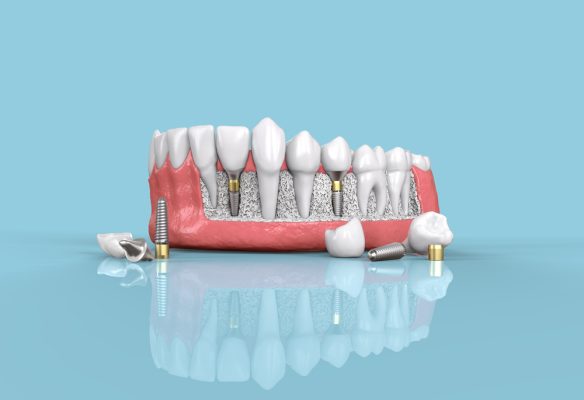Safe Dental Implant Surgery in Wasilla
The idea of undergoing a surgical procedure can be daunting or overwhelming. However, our Wasilla dentist provides safe and comfortable dental implant surgery for those needing to replace one or multiple missing teeth.
Understand how a dental implant procedure works by reading our dental team’s comprehensive guide below so you can be better prepared for your upcoming treatment.

How The Dental Implant Procedure Works
Initial Consultation
The first step in receiving dental implants is to schedule an initial consultation with a qualified implant dentist or oral surgeon. During this appointment, they’ll examine your mouth and take digital X-rays to determine if you’re a good candidate for treatment. They’ll also discuss your medical history and any medications you’re taking to make sure that the implant surgery is safe for you.
Supplemental Procedures
For some patients, supplemental procedures may be recommended before they can move forward with replacing missing teeth with dental implants. Procedures such as bone grafting and soft tissue grafting are common for those suffering from low jawbone density or who have underlying oral health conditions, such as gum disease.
These supplemental procedures can be performed before or during the implant process, depending on the patient’s needs and the complexity of their case. Your dentist or oral surgeon will evaluate your specific situation and determine if any additional procedures are necessary to ensure the success of your dental implant procedure.
In some cases, dental implants may not be right for you. Your dental specialists may recommend other restorative dentistry treatments, such as removable dentures or a dental bridge.
Implant Surgery
The implant surgery is typically an outpatient procedure done under local anesthesia, but some patients may choose to have IV sedation for added comfort. Sedation options are discussed at the initial consultation. During the procedure, the dentist will make a small incision in the gums and carefully place the implant post into the jawbone. The post will then be left to heal and integrate with the bone in the coming months.
Depending on your dentist, they may perform the surgery with the help of 3D scanning technology, or even laser technology.
Recovery Period
During the recovery period, the post will begin the process of osseointegration. Osseointegration is a natural process where the bone around the implant post begins to fuse with the jawbone. This process is essential for the implant to be secure and stable. It takes several months for osseointegration to be completed.
The healing time for osseointegration varies for each patient, but you’ll be able to return to your normal routine after a few days. Make sure to stick to soft foods diet and follow any instructions provided. You may have some discomfort or swelling for a few days to a week.
Remember, each patient heals differently, so the entire dental implant timeline will fluctuate for each person.
Final Restoration Placement
Once the post has fully integrated with the jawbone, you’ll return to the dentist for the final restoration placement appointment. Your custom restoration, a dental crown, bridge, or supported denture will be ready for placement. The final restoration will be securely attached to the post to look and function just like a natural tooth. You’ll leave the dental office with a brand-new, beautiful smile that you’ll love.
Follow-Up Visits
You’ll need to maintain regular visits to your dentist to ensure that your implant, abutment, and crown are functioning properly. These are always necessary to ensure that your overall oral health remains in excellent condition.

After Your Dental Implant Surgery
After your dental implant surgery, it’s essential to take great care of your oral hygiene to ensure proper healing and reduce your chance of implant complications arising. Here are some tips to help you out after oral surgery:
- Follow your dentist’s instructions
- Manage pain and swelling with cold compresses and over-the-counter pain medications
- Avoid smoking and drinking alcohol
- Eat soft foods and avoid anything hard, crunchy, or spicy
- Practice good oral hygiene
- Attend follow-up appointments
To learn more about post-op dental implant care, our Wasilla dentist has created a detailed before and after dental implant surgery guide to assist you with a speedy recovery.
Frequently Asked Questions
Not necessarily. In some cases, dental implants can be placed directly into the jawbone without the need to remove any existing teeth. However, if there aren’t enough healthy teeth or if the jawbone is too thin or weak, tooth extraction may be necessary before the implant surgery.
On average, the process takes about four to six months. The implant surgery itself takes just a few hours during one appointment, but the post needs time to heal and integrate with the jawbone before your dentist places the final restoration, typically a dental crown or bridge. Osseointegration can take anywhere from three to six months and is a crucial step as this is when your implant post naturally fuses with your jawbone.
The 3 stages of dental implants include the initial consultation, implant surgery, and placing the final restoration. Your dentist will begin by examining your dental health to ensure a dental implant is the best tooth replacement option. Then, you’ll undergo implant placement surgery and that will act as the base of your artificial teeth.
After a three to six-month recovery period, your dentist will place your custom prosthetic tooth. While it’s typically a dental crown, some patients may get a dental bridge or supported implant dentures.
Most patients can expect to undergo this 3 stage process. However, some may need additional procedures for underlying oral health conditions, such as tooth decay, periodontal disease, or low bone density.
Most patients report little to no pain during the dental implant procedure. A local anesthetic is used to numb the area, or your dentist may offer alternative dental sedation options depending on your needs.
After the implant procedure, patients usually manage any discomfort or swelling with over-the-counter medications.
Start Your New Smile Journey With Dental Implants
Do you still have questions about the dental implant procedure? Contact our Wasilla dentist today. With years of experience in implant dentistry, he’ll answer any questions you may have about the dental procedure and help you determine if dental implants are right for you.
